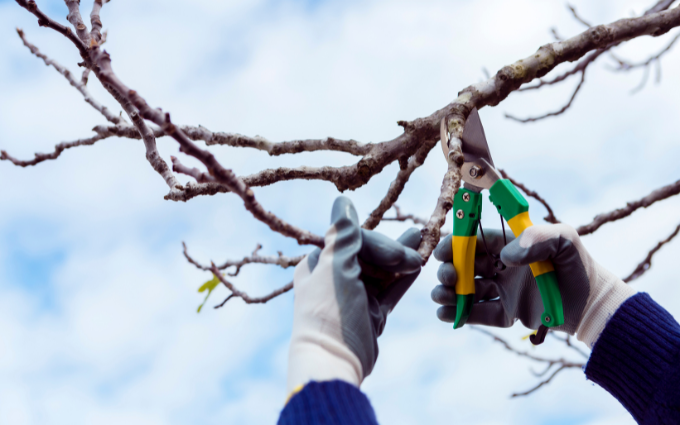Read This Blog First Before You Attempt DIY Tree Care on Your Property
Tree pruning is a vital aspect of tree care that not only enhances the aesthetic appeal of your landscape, but also promotes the health and longevity of your trees. Proper tree pruning is a skill that, when done correctly, can yield numerous benefits. However, when done incorrectly, it can hurt the tree and make it more susceptible to diseases and invasive pests.
In this blog, we’ll explore the reasons why trees need to be pruned and provide valuable tips and best practices for this essential task. We’ll also provide information on how to secure tree pruning services for jobs that require a professional touch combined with arborist-level tree knowledge.
Why Is Tree Pruning Necessary?
Trees are among the mightiest plants in the world. Some of them tower over 400 feet. They can also live to be thousands of years old. While other plants shrivel and expire during cold winter weather, trees can withstand frigid temperatures, ice, and harsh winds for months.
When you stop to consider how powerful trees are, it’s difficult to imagine they’d need any kind of human assistance to remain healthy. However, just like any living organism, trees have weaknesses and challenges they must overcome, which brings us to the topic of tree pruning.
Why do homeowners need to prune their trees? Think of your tree’s growth pattern and structural integrity like architecture. If a tree is allowed to grow unchecked, it can lead to compromised structural integrity, such as too much weight being placed on a particular branch.
Trees that have uneven weight distribution are at the highest risk of experiencing breakage or cracks, especially during the winter months when snow and ice are added into the mix. By adhering to tree pruning best practices, homeowners can mitigate emergency tree issues that can impact nearby property or pedestrians.
Check out these other main reasons why tree pruning is important:
- Health
- Aesthetics
- Light and airflow
Pruning promotes the overall health of a tree by removing diseased, dead, or pest-infested branches. This prevents the further spread of disease and allows the tree to allocate water and nutrients to healthy branches.
The process also enhances the appearance of trees by removing unsightly branches and maintaining a balanced, lush canopy. Well-pruned trees add beauty and value to your landscaping and boost curb appeal.
Proper pruning allows more sunlight to reach the tree’s interior branches and improves air circulation, both of which help facilitate healthy growth.
Tree Pruning Tips and Best Practices
Pruning trees is by no means an easy task. It requires the right tools, the right technique, and the right training to know what to cut and what not to cut. In fact, most big tree pruning jobs should be handled by a professional tree service to ensure it’s done correctly. Professional tree pruning services also account for tree species and which pests and diseases are most likely to play a factor.
Follow these common tips and best practices to follow when performing tree pruning in Kansas City:
- Timing: The best time to prune depends on the species of tree. For example, you should never prune a live oak in the summer unless it’s an emergency. Generally, late fall or early winter is the best time for tree pruning. Avoid heavy pruning during the growing season.
- Tools: Homeowners should invest in high-quality pruning tools that are sharp and make clean cuts. Tree pruners, loppers, trimmers, pole saws, and mini chainsaws can be found at your local hardware store or online. However, it’s especially important to brush up on safety best practices and cutting techniques before tree pruning. Not following chainsaw safety best practices, for example, can lead to an accident or critical injury.
- Use the three Ds: Knowing what to cut and what not to cut is an essential tree pruning skill. Start by removing dead, diseased, and damaged branches. These are usually easy to spot, as they often lack leaves, feature discolored leaves or bark, or are brittle with no growth.
- Avoid over-pruning: The foliage of a tree is used to create sustenance. Over-pruning hinders a tree’s ability to sustain, effectively starving it. Remember, each incorrect cut is costly to the tree.
- Undercutting: When cutting a branch, it’s best to come at it from the underside at a spot that’s a few inches away from the trunk. Using this technique will help prevent the tree’s bark from tearing.
- Step back occasionally: Shaping a canopy is both an art and a science. Periodically step back and assess your progress from a distance to ensure a balanced and aesthetically pleasing shape. Lopsided or misshapen trees won’t do your curb appeal any favors and may affect your tree’s structural integrity.
Don’t Hesitate to Contact a Professional for Tree Pruning Near You
Many homeowners prefer to be as self-sufficient as possible when it comes to maintaining their property and landscaping. Mowing your own lawn, cleaning your own house, and making your own repairs keeps expenses down and helps maintain the overall budget.
However, some jobs are too technical, too dangerous, or require a specialized knowledge that warrants hiring a professional – tree pruning being one of them. When homeowners invest in professional tree pruning services, they can rest assured the job will get done right and the structural integrity and health of their trees will be in the best condition possible.
Homeowners looking for tree pruning in Kansas City should find a local tree care service with expertise and the professional-grade tools to perform this essential task. A professional tree service can assess the health of the trees on your property and make recommendations that will help them blossom during next year’s growing season.

